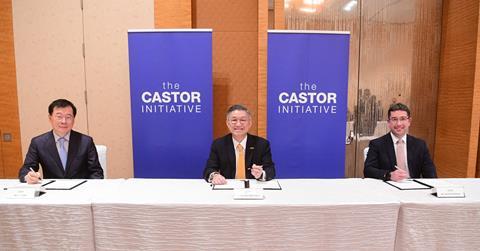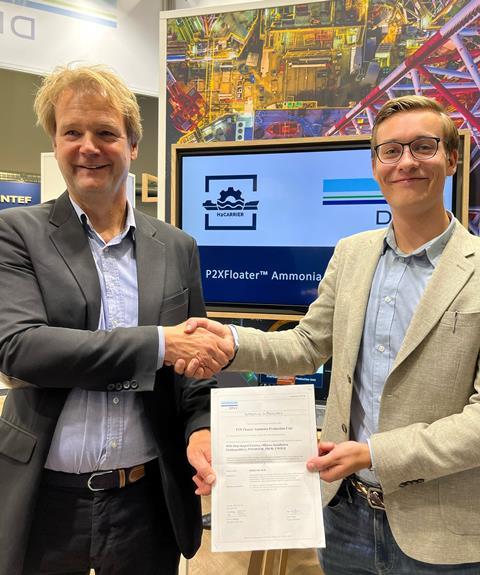In the latest of a string of projects promoting ammonia as ship fuel, DNV has awarded Approval in Principle (AiP) for a floating green ammonia production unit.
The so-called P2XFloater concept, developed by Norway-based H2 Carrier, is based on the conversion of an existing very large gas carrier into a floating, production, storage and offloading unit (FPSO) that can produce environmentally friendly ammonia.
The FPSO would source electricity from a wind farm or other renewable source to provide power for electrolysis of seawater to produce the hydrogen as feedstock for a Haber-Bosch processing plant which would produce liquid ammonia by combining hydrogen and nitrogen of under high pressure and high temperature. The required nitrogen would also be produced onboard the FPSO.
“The innovative P2XFloater™ concept provides a low-cost, fast-track and flexible solution to produce green ammonia on an industrial scale and at a competitive price. Market demand is rapidly increasing primarily due to the decarbonisation of the industrial and maritime sectors,” says Mårten Lunde, CEO of H2Carrier AS.
Subsea storage
The news comes as ABS has announced it is qualifying a subsea ammonia storage system developed by NOV. The Joint Development Project includes NOV, ABS, Equinor, Shell, The Research Council of Norway and The Net Zero Technology Centre.
The unique subsea technology can be used to store large volumes of fluids such as enhanced oil recovery chemicals, production chemicals, oil, condensate, and maritime fuels. It is being designed so that it can be placed at any water depth and adjusted in capacity depending on customer requirements.
“The subsea storage technology is one of those game-changing technologies, allowing the storage on the seabed of all type of fluids whether it is for the oil and gas industry, as an all-electric enabler, or e-fuels such as e-methanol and liquid ammonia for the rapidly growing shipping industry,” said Jan Rytter, R&D Director, NOV.
Advantages of ammonia as bunker fuel
As ammonia does not contain carbon, it does not emit CO₂ when combusted. It has an energy density similar to methanol and more favourable than hydrogen, notes the Global Maritime Forum. Additionally, it requires less cooling than cryogenic liquid hydrogen. The Haber-Bosch process is efficient and fully scaled. It requires less energy than the synthesis of methanol or e-methane, so ammonia is likely to be cheaper than either of these fuel options.
New ship designs emerging
Earlier this year, three members of the Castor Initiative signed an agreement to develop zero-emission VLCCs running on ammonia. Lloyd’s Register, Samsung Heavy Industries and MISC via its subsidiary, AET, all founding members of The Castor Initiative, expect the first of the dual-fuel VLCCs to enter into service in late 2025 and the second in early 2026.
The Castor Initiative includes MISC Berhad, Lloyd’s Register, Samsung Heavy Industries, MAN Energy Solutions, the Maritime and Port Authority of Singapore, Yara International ASA and Jurong Port. The members will focus on identifying green shipping corridors to facilitate the bunkering of the zero-emission VLCCs.
In June, Samsung Heavy Industries received AiP from ABS for its design of an ammonia-fuelled Neo-Panamax container vessel. And last year, SHI signed an agreement with Wärtsilä for the development of ammonia-fuelled vessels with 4-stroke auxiliary engines. SHI envisages container ships and VLCCs operating with 2-stroke main engines and 4-stroke Wärtsilä auxiliary engines. SHI has also gained AiP from DNV for the design of an ammonia-ready VLCC.
“Three members of the Castor Initiative ink an MoU for Zero-emission VLCCs” “/ / 
Source: Castor Initiative
Lloyd’s Register, Samsung Heavy Industries and AET inked an MoU for Zero-emission VLCCs
Bunker vessel development underway
The development of ammonia bunker vessels is also underway. Keppel Offshore and Marine has received AiP from ABS for its ammonia bunker vessel design. The development is part of Project Sabre, an initiative undertaken by a consortium of maritime companies to develop a ship-to-ship-based ammonia bunker supply chain in Singapore. In addition to ABS and Keppel Offshore and Marine, the consortium is comprised of AP Moller-Maersk, Fleet Management, the Maersk Mc-Kinney Møller Center for Zero Carbon Shipping, Sumitomo Corporation, K Line, and the Maritime and Port Authority of Singapore.
In July, Yara Clean Ammonia and Pilbara Ports Authority agreed to jointly facilitate the uptake of clean ammonia as a marine fuel in the Pilbara region in Western Australia.
Outlook is positive
IRENA’s 2021 report A Pathway to Decarbonise the Shipping Sector by 2050 predicts that e-ammonia will be the backbone for decarbonising international shipping in the medium and long term. The validation of ammonia engine designs by 2023 will be a key milestone. In a 2022 Outlook, IRENA notes that although technological challenges are not expected to be a significant hurdle for its uptake by shipping, experience with ammonia fuel is required before it can be widely adopted, including the development of new or revised codes and standards.






